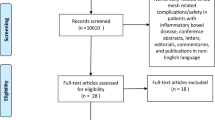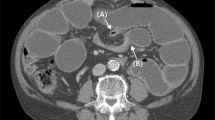Abstract
Introduction
Multiple laparotomies, immunosuppressive therapy, wound infection, and malnutrition are risk factors for incisional hernia development, which places inflammatory bowel disease (IBD) patients at high risk. With advances in minimally invasive techniques, this study assesses incisional hernia repair techniques and complications in the IBD population.
Methods
A single-center, retrospective review of adults with IBD who underwent incisional hernia repair from 2008 to 2022. Complications relative to operative approach and mesh placement location were assessed using descriptive and univariate statistics.
Results
Eighty-eight IBD patients underwent incisional hernia repair. Fifty-two (59.1%) were on immunomodulators and 30 (34.1%) were repaired primarily. Thirty-five (39.7%) hernias recurred, of whom 19 (33%) had mesh placed. Three (30%) occurred in onlay repairs and 16 (33%) occurred in underlay repairs. Subdivision of underlay repairs into intraperitoneal, preperitoneal and retrorectus mesh placement revealed recurrence rates of 35.1%, 50%, and 14.3%, respectively. Patients with open repair were more likely to have intraoperative bowel injury (28.6% vs 9.7%, p = 0.041) and develop postoperative seromas/abscesses (12.5% vs 0%, p = 0.001) and wound complications (17.9% vs 0%, p = 0.012) compared to laparoscopic. Seromas/abscesses developed more frequently in onlay repairs compared to underlay (40% vs 2.13%, p = 0.001). Twelve (13.6%) patients presented with postoperative small bowel obstruction (SBO), 7 (58.3%) of whom had mesh placed, and 6 (85.7%) were underlay. All SBO after underlay repair had intraperitoneally placed mesh. When comparing surgeons, hernias were more likely to recur performed by colorectal surgeons compared to hernia surgeons (63.3% vs 21.3%, p < 0.001).
Conclusion
In IBD patients, minimally invasive approaches lead to fewer perioperative complications compared to open. Underlay mesh placement demonstrated decreased incidence of seroma/abscess formation compared to onlay. When sub-grouped, underlay placements were similar in terms of complications. Retrorectus placement, however, had fewer recurrences and no readmissions for SBO. This suggests a minimally invasive approach or placement of retrorectus mesh may provide the optimal repair in this patient population.
Similar content being viewed by others
References
Le Huu NR, Mege D, Ouaïssi M, Sielezneff I, Sastre B (2012) Incidence and prevention of ventral incisional hernia. J Visc Surg 149(5, Supplement):e3–e14
Mingoli A, Puggioni A, Sgarzini G et al (1999) Incidence of incisional hernia following emergency abdominal surgery. Ital J Gastroenterol Hepatol 31(6):449–453
Veljkovic R, Protic M, Gluhovic A, Potic Z, Milosevic Z, Stojadinovic A (2010) Prospective clinical trial of factors predicting the early development of incisional hernia after midline laparotomy. J Am Coll Surg 210(2):210–219
Sørensen LT, Hemmingsen U, Kallehave F et al (2005) Risk factors for tissue and wound complications in gastrointestinal surgery. Ann Surg 241(4):654–658
Solina G, Mandalà S, La Barbera C, Mandalà V (2016) Current management of intestinal bowel disease: the role of surgery. Updates Surg 68(1):13–23
Heimann TM, Swaminathan S, Greenstein AJ, Steinhagen RM (2018) Incidence and factors correlating with incisional hernia following open bowel resection in patients with inflammatory bowel disease: a review of 1000 patients. Ann Surg 267(3):532–536
Henriksen NA, Friis-Andersen H, Jorgensen LN, Helgstrand F (2021) Open versus laparoscopic incisional hernia repair: nationwide database study. BJS Open 5(1):zraa010
Alimi Y, Merle C, Sosin M, Mahan M, Bhanot P (2020) Mesh and plane selection: a summary of options and outcomes. Plast Aesthet Res. https://doi.org/10.20517/2347-9264.2019.39
Köckerling F (2018) Onlay technique in incisional hernia repair—a systematic review. Front Surg 5:71
Sosin M, Nahabedian MY, Bhanot P (2018) The perfect plane: a systematic review of mesh location and outcomes, update 2018. Plast Reconstr Surg 142:107S–116S
El Boghdady M, Ewalds-Kvist BM, Laliotis A (2022) Abdominal hernia mesh repair in patients with inflammatory bowel disease: a systematic review. Langenbecks Arch Surg 407(7):2637–2649
Hope WW, Tuma F (2022) Incisional hernia. In: StatPearls. StatPearls Publishing. http://www.ncbi.nlm.nih.gov/books/NBK435995/. Accessed 12 Mar 2023
Muysoms FE, Miserez M, Berrevoet F et al (2009) Classification of primary and incisional abdominal wall hernias. Hernia 13(4):407–414
Heise D, Schram C, Eickhoff R et al (2021) Incisional hernia repair by synthetic mesh prosthesis in patients with inflammatory bowel disease: a comparative analysis. BMC Surg 21(1):353
Pereira C, Rai R (2021) Open versus laparoscopic ventral hernia repair: a randomized clinical trial. Cureus 13(12):e20490
Zhang Y, Zhou H, Chai Y, Cao C, Jin K, Hu Z (2014) Laparoscopic versus open incisional and ventral hernia repair: a systematic review and meta-analysis. World J Surg 38(9):2233–2240
Rogmark P, Petersson U, Bringman S et al (2013) Short-term outcomes for open and laparoscopic midline incisional hernia repair: a randomized multicenter controlled trial: the ProLOVE (prospective randomized trial on open versus laparoscopic operation of ventral eventrations) trial. Ann Surg 258(1):37–45
Mathes T, Walgenbach M, Siegel R (2016) Suture versus mesh repair in primary and incisional ventral hernias: a systematic review and meta-analysis. World J Surg 40(4):826–835
Sauerland S, Walgenbach M, Habermalz B, Seiler CM, Miserez M (2011) Laparoscopic versus open surgical techniques for ventral or incisional hernia repair. Cochrane Database Syst Rev. https://doi.org/10.1002/14651858.CD007781.pub2
Mathes T, Walgenbach M, Siegel R (2015) Suture versus mesh repair in primary and incisional ventral hernias: a systematic review and meta-analysis. World J Surg 40(4):826–835
Nguyen SQ, Teitelbaum E, Sabnis AA, Bonaccorso A, Tabrizian P, Salky B (2009) Laparoscopic resection for Crohn’s disease: an experience with 335 cases. Surg Endosc 23(10):2380–2384
Misra MC, Bansal VK, Kulkarni MP, Pawar DK (2006) Comparison of laparoscopic and open repair of incisional and primary ventral hernia: results of a prospective randomized study. Surg Endosc 20(12):1839–1845
Sevinç B, Okuş A, Ay S, Aksoy N, Karahan Ö (2018) Randomized prospective comparison of long-term results of onlay and sublay mesh repair techniques for incisional hernia. Turk J Surg 34(1):17
Rhemtulla IA, Fischer JP (2018) Retromuscular sublay technique for ventral hernia repair. Semin Plast Surg 32(3):120–126
Author information
Authors and Affiliations
Corresponding author
Ethics declarations
Disclosures
Nikita Ramanathan, Matthew F. Mikulski, Aixa M. Perez Coulter, Neal E. Seymour, and Georgios Orthopoulos have no conflicts of interest or financial ties to disclose.
Additional information
Publisher's Note
Springer Nature remains neutral with regard to jurisdictional claims in published maps and institutional affiliations.
Appendix
Appendix
ICD-10 codes for IBD:
-
K50 Crohn’s disease
-
K51 ulcerative colitis
ICD-9 codes for IBD:
-
555.9 Crohn’s disease
-
556.9 ulcerative colitis
Open hernia repair CPT codes:
-
49,560 repair initial incisional or ventral hernia, reducible
-
49,561 repair initial incisional or ventral hernia, incarcerated or strangulated
-
49,565 repair recurrent incisional or ventral hernia, reducible
-
49,566 repair recurrent incisional or ventral hernia, incarcerated or strangulated
Laparoscopic/robotic hernia repair CPT codes:
-
49,654 laparoscopy, surgical, repair, incisional hernia (includes mesh insertion, when performed), reducible
-
49,655 laparoscopy, surgical, repair, incisional hernia (includes mesh insertion, when performed), incarcerated or strangulated
-
49,656 laparoscopy, surgical, repair, recurrent incisional hernia (includes mesh insertion, when performed), reducible
-
49,657 laparoscopy, surgical, repair, recurrent incisional hernia (includes mesh insertion, when performed), incarcerated or strangulated
ICD-10 codes for complications:
-
K43.0 incisional hernia with obstruction, without gangrene
-
K43.1 incisional hernia with gangrene
-
K43.2 incisional hernia without obstruction or gangrene
-
K43.3 parastomal hernia with obstruction, without gangrene
-
K43.4 parastomal hernia with gangrene
-
K43.5 parastomal hernia without obstruction or gangrene
ICD 9 codes for complications:
-
552.21 incisional hernia with obstruction
-
553.21 incisional hernia without obstruction or gangrene
-
551.21 incisional ventral hernia with gangrene
Rights and permissions
Springer Nature or its licensor (e.g. a society or other partner) holds exclusive rights to this article under a publishing agreement with the author(s) or other rightsholder(s); author self-archiving of the accepted manuscript version of this article is solely governed by the terms of such publishing agreement and applicable law.
About this article
Cite this article
Ramanathan, N., Mikulski, M.F., Perez Coulter, A.M. et al. Investigation of optimal hernia repair techniques in patients with inflammatory bowel disease. Surg Endosc 38, 975–982 (2024). https://doi.org/10.1007/s00464-023-10537-5
Received:
Accepted:
Published:
Issue Date:
DOI: https://doi.org/10.1007/s00464-023-10537-5




